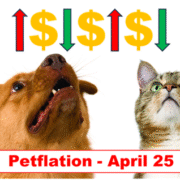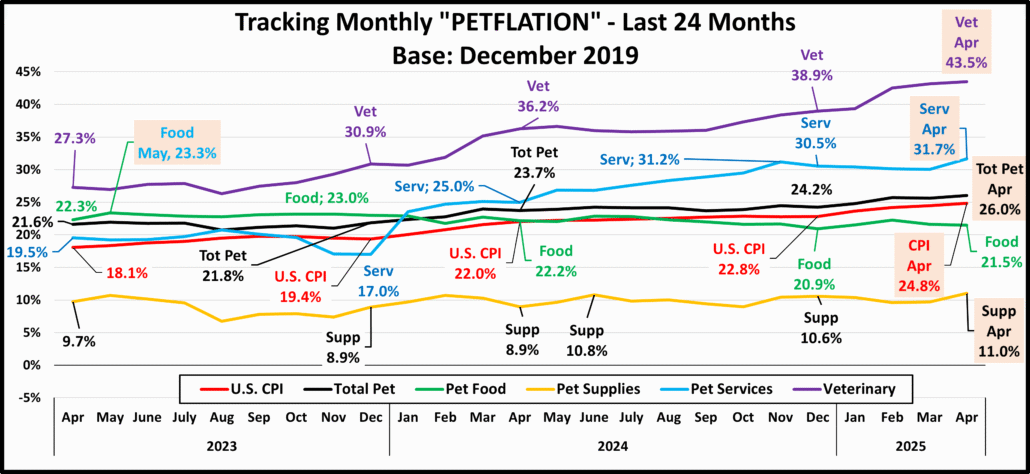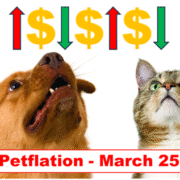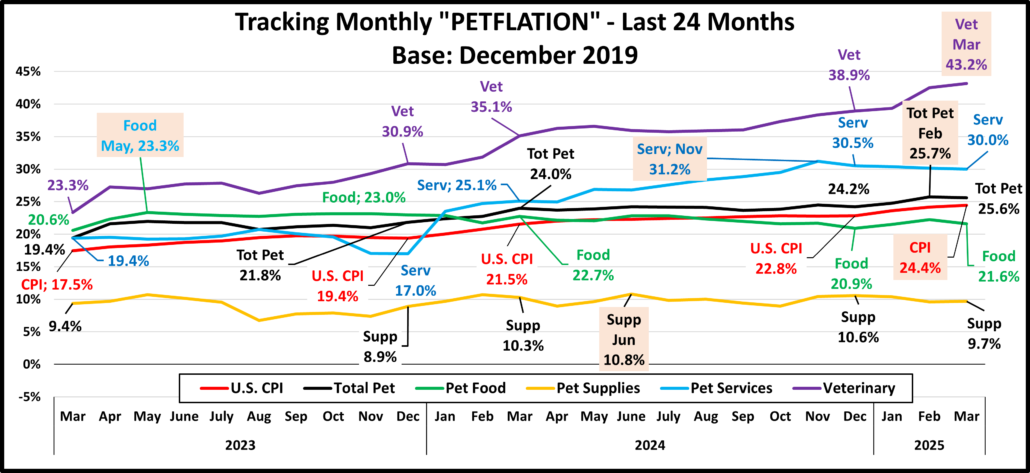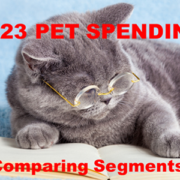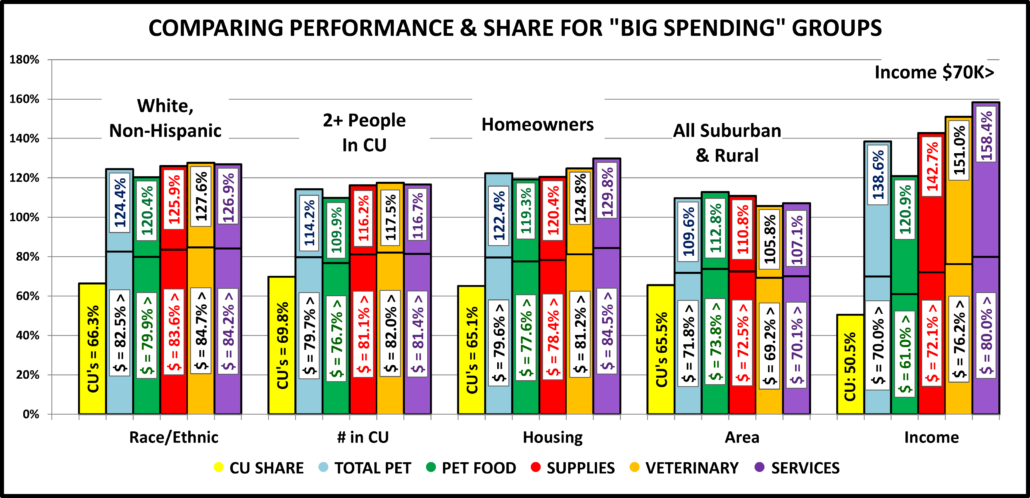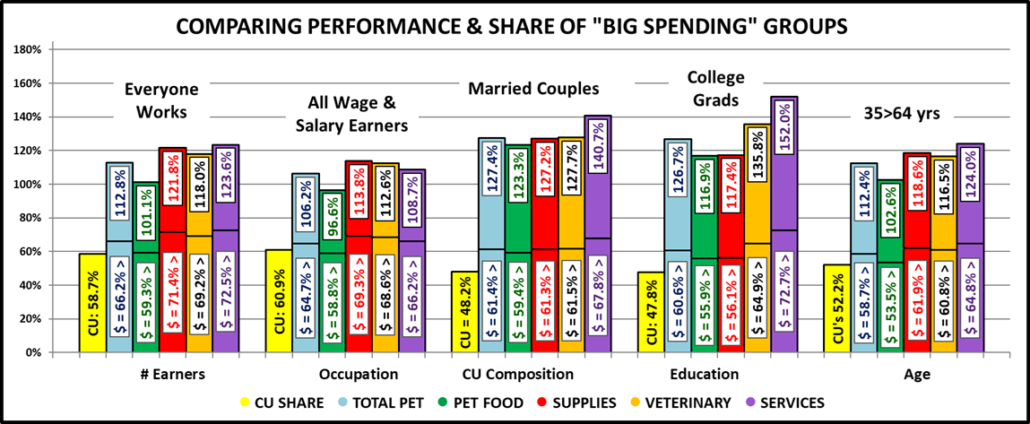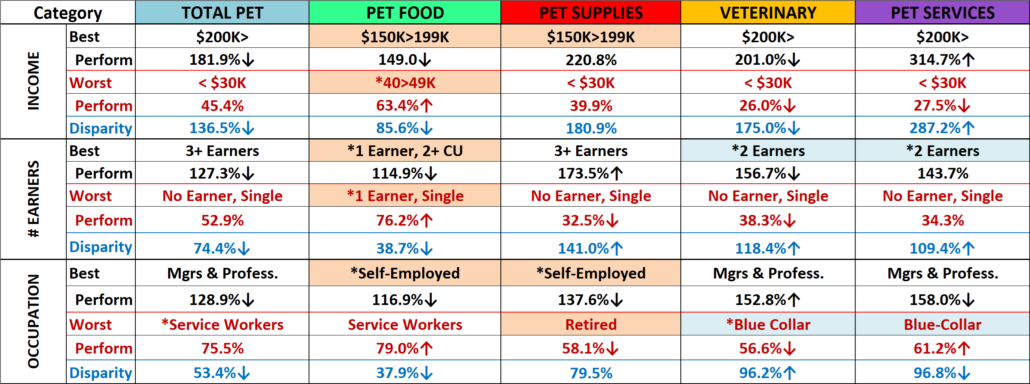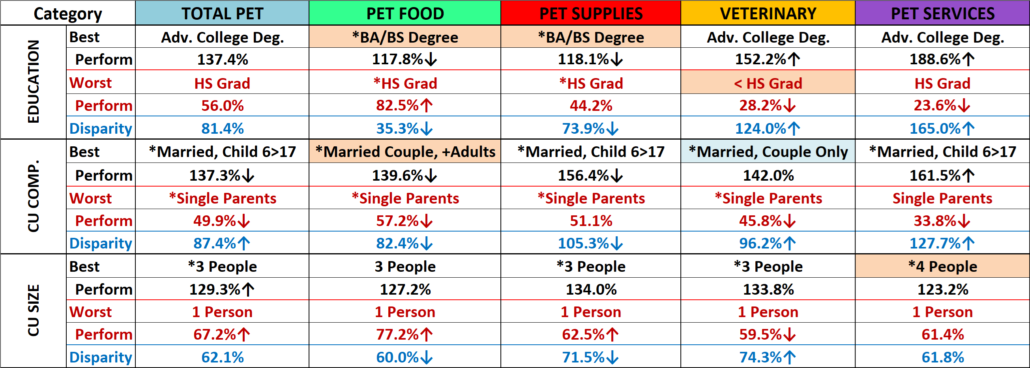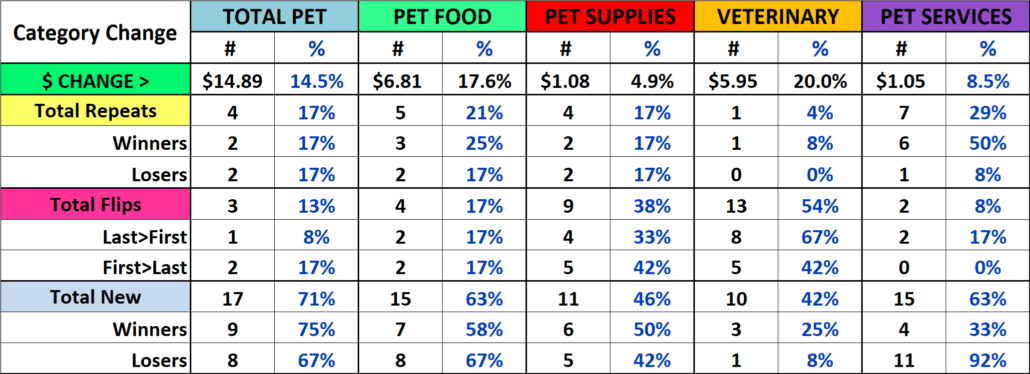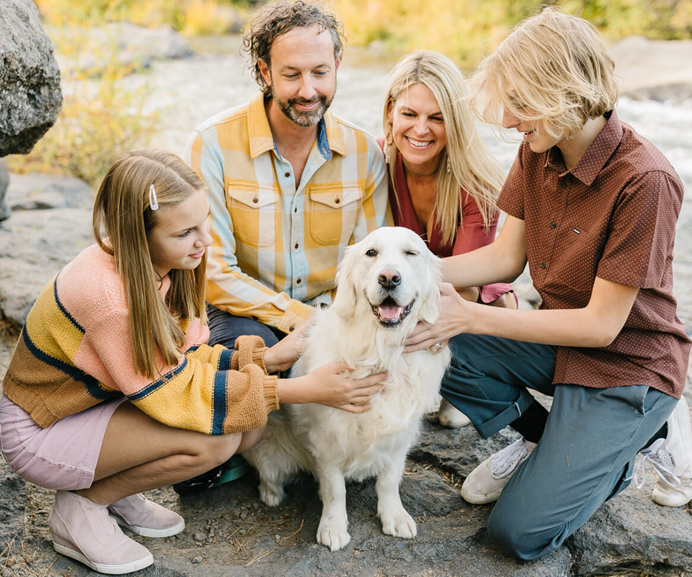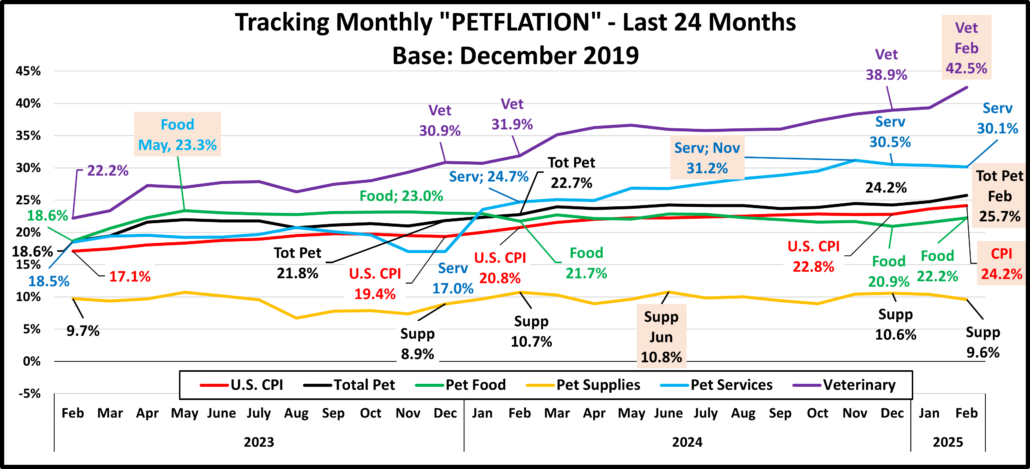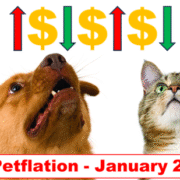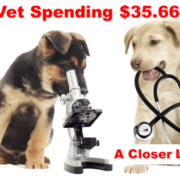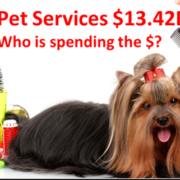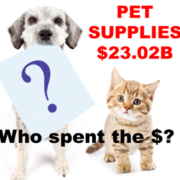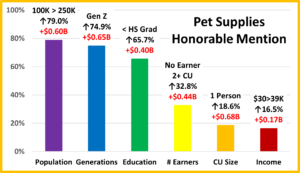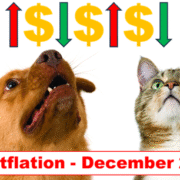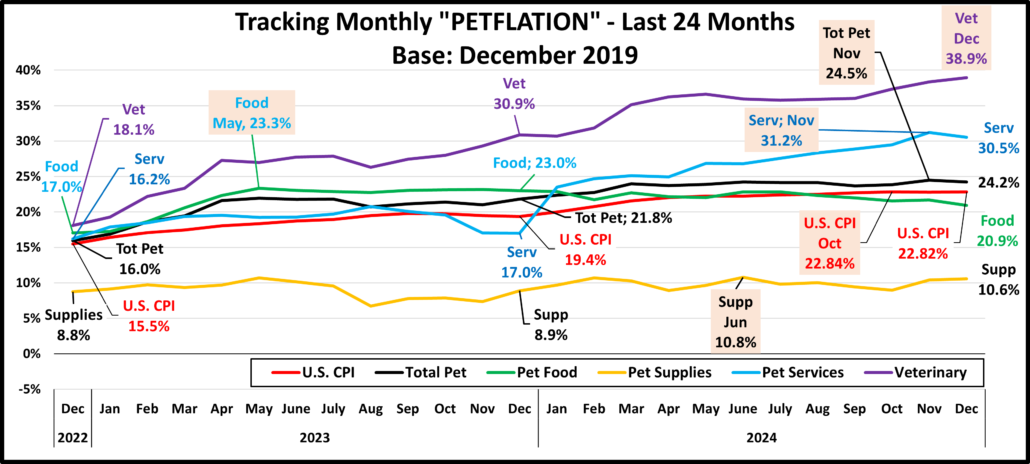Petflation 2025 – May Update: Moves Up to +2.2% vs Last Year
The monthly Consumer Price Index peaked back in June 2022 at 9.1% then began to slow until it turned up in Jul/Aug 2023. Prices fell in Oct>Dec 23, then turned up Jan>Oct 24 but fell -0.1% in Nov. However, they have now risen for 6 straight months, including a 0.2% lift in May to a new record high. The CPI vs 24 also increased to +2.4% from +2.3% in April. Grocery prices rose 0.2% from April and YOY inflation grew from 2.0% to 2.2%. Even minor price changes can affect consumer pet spending, especially in the discretionary pet segments, so we will continue to publish monthly reports to track petflation as it evolves in the market.
Petflation was +4.1% in Dec 21 while the overall CPI was +7.0%. The gap narrowed as Petflation accelerated and reached 96.7% of the national rate in June 22. National inflation has slowed considerably since then, but Petflation generally increased until June 23. It passed the CPI in July 22 but fell below it from Apr>Jul 24. It exceeded the CPI in August, fell below in Sep>Oct, rose above in Nov, then fell below in Dec>May 25. As we drill into the data, all reports will include:
- A rolling 24 month tracking of the CPI for all pet segments and the national CPI. The base number will be pre-pandemic December 2019 in this and future reports, which will facilitate comparisons.
- Monthly comparisons of 25 vs 24 which will include Pet Segments and relevant Human spending categories. Plus
- CPI change from the previous month.
- Inflation changes for recent years (23>24, 22>23, 21>22, 20>21, 19>20, 18>19)
- Total Inflation for the current month in 2025 vs 2019 and vs 2021 to see the full inflation surge.
- Average annual Year Over Year inflation rate from 2019 to 2025
- YTD comparisons
- YTD numbers for the monthly comparisons #2>4 above
In our first graph we will track the monthly change in prices for the 24 months from May 23 to May 25. We will use December 2019 as a base number so we can track the progress from pre-pandemic times through an eventual recovery. This chart is designed to give you a visual image of the flow of pricing. You can see the similarities and differences in segment patterns and compare them to the overall U.S. CPI. The year-end numbers from 12 and 24 months earlier are included. We also included and highlighted (pink) the cumulative price peak for each segment. In May, Pet prices were up 0.5% from Apr. All were up – Food (+0.01%); Vet (+0.5%); Services (+1.1%); Supplies (+0.5%)
In May 23, the CPI was +18.3% and Pet was +21.9%. The Services segments inflated after mid-20, while Product inflation stayed low until late 21. In 22, Food prices grew but the others had mixed patterns until July 22, when all rose. In Aug>Oct Petflation took off. In Nov>Dec, Services & Food inflated while Vet & Supplies prices stabilized. In Jan>Apr 23, prices grew every month for all segments except for 1 Supplies dip. In May Product prices grew while Services slowed. In Jun/Jul this reversed. In Aug all but Services fell. In Sep/Oct this flipped. In Nov, all but Food & Vet fell. In Dec, Supp. & Vet drove prices up. In Jan>Mar 24 prices grew. In April, prices in all but Vet fell. In May, all but Food grew. In June, Products drove a lift. In July, all but Services fell. In Aug, Food drove a drop. In Sep, Products fueled a drop. Services drove a lift in Oct. In Nov, all were up. After the drop in March 25, all but Food reached record highs in April & May.
- U.S. CPI – The inflation rate was below 2% through 2020. It turned up in January 21 and continued to grow until flattening out in Jul>Dec 22. Prices rose Jan>Sep 23, fell Oct>Dec, rose Jan>Oct 24, fell Nov, then rose Dec>May to a record high but 27.1% of the increase since Dec 19 happened from Jan>Jun 22 – 9.2% of the time.
- Pet Food – Prices were at the Dec 19 level Apr 20>Sep 21. They grew & peaked May 23. Jun>Aug ↓, Sep>Nov↑, Dec>Feb↓, Mar↑, Apr>May↓, June↑, Jul>Oct↓, Nov↑, Dec↓, Jan>Feb↑, Mar>May↓. 99% of the lift occurred in 22/23.
- Pet Supplies – Supplies prices were high in Dec 19 due to tariffs. They had a deflated rollercoaster ride until mid-21 when they returned to Dec 19 prices & essentially stayed there until 22. They turned up in Jan 22 and hit a record high. They plateaued Feb>May, grew in June, flattened in July, then turned up in Aug>Oct to a new record. Prices stabilized in Nov>Dec but grew in Jan>Feb 23. They fell in Mar, but the rollercoaster continued with Dec>Feb↑, Mar/Apr↓, May/Jun↑, July↓, Aug↑, Sep/Oct↓ & Nov/Dec↑, Jan>Feb 25↓, Mar>May↑ to a new record high.
- Pet Services– Inflation is usually 2+%. Perhaps due to closures, prices increased at a lower rate in 2020. In 2021 consumer demand increased but with fewer outlets. Inflation grew in 21 with the biggest lift in Jan>Apr. Inflation was strong in 22 but prices got on a rollercoaster in Mar>Jun. They turned up Jul>Apr 23 but prices fell in May. Jun>Aug↑, Sep>Dec↓, Jan>Mar 24↑, Apr↓, May↑, June↓, Jul>Nov↑, Dec>Mar 25↓, Apr>May↑, a record!
- Veterinary – Inflation has been consistent. Prices turned up in Mar 20 and grew through 21. A surge began in Dec 21 which put them above the overall CPI. In May 22 prices fell and stabilized in June causing them to fall below the CPI. However, prices rose again and despite some dips they have stayed above the CPI since July 22. In 23>24 prices grew Jan>May, leveled Jun/Jul, fell Aug, grew Sep>Dec, fell Jan 24, grew Feb>May, fell Jun>Jul, then grew Aug>May 25.
- Total Pet – Petflation is a sum of the segments. In Dec 21 the price surge began. In Mar>Jun 22 the segments had ups & downs, but Petflation grew again from Jul>Nov. It slowed in Dec, grew Jan>May 23 (peak), fell Jun>Aug, grew Sep/Oct, then fell in Nov. In December prices turned up and grew through Mar 24 to a record high. Prices fell in April, rose May>Jun, fell Jul>Sep, rose Oct>Nov, fell in Dec, rose Jan>Feb, fell Mar, then set records in Apr>May.
Next, we’ll turn our attention to the Year Over Year inflation rate change for May and compare it to last month, last year and to previous years. We will also show total inflation from 21>25 & 19>25. Petflation rose from 1.9% to 2.2% but it is still below the National inflation rate (only by -8.3%). The chart will allow you to compare the inflation rates of 24>25 to 23>24 and other years but also see how much of the total inflation since 2019 came from the current pricing surge. We’ve included some human categories to put the pet numbers into perspective.
Overall, prices were up 0.2% from April and were +2.4% vs May 24, up from +2.3% last month. Grocery inflation grew to 2.2% from 2.0%. None had price decreases from last month, down from 2 in April & 3 in March. There were also 2 drops in Oct/Nov but 3 in Aug/Sep/Dec/Mar and 5 back in July. The national YOY monthly CPI rate of 2.4% is up from 2.3%, but 27.3% below the 23>24 rate and 72% less than 21>22. The 24>25 rate is above 23>24 for 4 – Groceries & 3 Pet – Supplies, Food & Total. In our 2021>2025 measurement you also can see that over 75% of the cumulative inflation since 2019 has occurred in 6 segments, 4 are Pet – all but Services, plus Groceries & the CPI. Except for Pet & Vet Services, where prices have surged, Service Segments have generally had higher inflation rates so there was a smaller pricing lift in the recent surge. Pet Products have a very different pattern. The 21>25 inflation surge actually provided 102% of their overall inflation since 2019. This happened because Pet Products prices in 2021 were starting to recover from a deflationary period. Services expenditures account for 63.8% of the National CPI so they are very influential. Their current CPI is +3.7% while the CPI for Commodities is -0.1%. This shows that Services are driving all of the current 2.4% inflation. The situation in Pet is similar but products have a bigger share of $. Petflation is 2.2%. The combined CPI for the Service Segments is 4.9%, while the Pet Products CPI is 0.2%.
- U.S. CPI– Prices are +0.2% from Apr. The YOY increase is 2.4%, up from 2.3%. It peaked at +9.1% back in June 2022. The targeted inflation rate is <2% so we are still 20+% higher than the target. The Apr/May lifts follow Feb/Mar drops, 4 straight lifts and 6 consecutive drops from Apr>Sep 24. The current rate is below 23>24 but the 21>25 rate is still +19.4%, 76.1% of the total inflation since 2019. The Inflation surge took off in April 2021, +4.2%, up from 2.6%.
- Pet Food– Prices are +0.01% vs Apr and -0.5% vs May 24. Deflation slowed from -0.6% in Apr. However, they are still far below the Food at Home inflation rate of +2.2%. The YOY Pet Food CPI has now deflated in 14 of the last 15 months. The 2021>2025 inflation surge has generated 99.1% of the 22.4% inflation since 2019. Inflation began for Pet Food in June 2021, +0.9%, after 12 straight deflationary months.
- Food at Home – Prices are +0.2% from Apr, and the YOY increase rose to 2.2% from 2.0%. This is still radically lower than Jul>Sep 2022 when it exceeded 13%. The 29.1% Inflation for this category since 2019 is 14% more than the national CPI but only in 4th place behind 3 Services expenditures (2 Pet). 76.6% of the inflation since 2019 occurred from 2021>25. This is about the same as the CPI, but we should note that Grocery prices began inflating in 2020>21 then the rate accelerated. It appears that the pandemic supply chain issues in Food which contributed to higher prices started early and foreshadowed problems in other categories and the overall CPI surge.
- Pets & Supplies– Prices were +0.5 from Apr but inflation slowed to 1.7% from 1.9%. They still have the lowest rate vs 2019. Prices were deflated for much of 20>21. As a result, the 2021>25 inflation surge accounted for 115% of the total price increase since 2019. Prices set a record in October 2022 then deflated. 3 lifts pushed them to a record high in Feb 23. Prices fell March, rose Apr/May, fell Jun>Aug, grew Sep/Oct, fell Nov, grew Dec>Feb 24, fell Mar/Apr, rose May/Jun, fell July, rose Aug, fell Sep/Oct, rose Nov/Dec, fell Jan/Feb 25, then rose Mar>May. (record high)
- Veterinary Services– Prices are +0.5% from Apr and their YOY CPI vs 24 grew to +5.6% from +5.3%. They returned to #1 in inflation vs 24 and are still the leader since 2019 with +47.4% and since 2021, +35.4%. For Veterinary, high annual inflation is the norm. However, the rate has increased during the current surge, especially since 23. They have the highest rate in 25, and 75% of the cumulative inflation since 2019 occurred from 2021>25.
- Medical Services – Prices turned sharply up at the start of the pandemic but then inflation slowed and fell to a low rate in 20>21. Prices were up +0.1% from Apr, but inflation vs 24 slowed to +3.0% from +3.1%. Medical Services are not a big part of the current surge as only 55.7% of the 18.5%, 2019>25 increase happened from 21>25.
- Pet Services – Inflation slowed in 2020 but began to grow in 21. In 24 prices surged Jan>Mar, fell in April, rose in May, fell in June, rose Jul>Nov, fell Dec>Mar 25 to 3.9%, then grew to 5.4% in Apr, but fell to 4.9% in May. They are now #2 in YOY inflation vs 24 and vs 21 & 19. 74.2% of their total 19>25 inflation is from 21>25. In Dec 23, it was 49%.
- Haircuts/Other Personal Services – Prices are +0.5% from Apr and +3.9% from May 24. 13 of the last 17 months have been 4.0+%. Inflation has been pretty consistent. 66.6% of the 19>25 inflation happened 21>25.
- Total Pet– Petflation rose to 2.2% from 1.9%. Only Food & Veterinary had higher rates but all, but food reached a record high price in May. 2.2% is 37.5% more than the 23>24 rate but 8.3% below the U.S. CPI. Plus, 2.2% is 29% below the average May Pet rate since 1997. May prices rose 5%, driven by all segments. A Apr>May decrease has happened only 5 times since 1997 (avg Chge: +0.2%, 60% less than 2025). The Pet CPI rose from 1.9% to 2.2% a 15.8% increase. A big factor in the 25 CPI lift was that prices only rose 0.15% in Apr>May 24, compared to 0.5% in 25. In 2025, we continue to move towards more normal spending patterns.
Now, let’s look at the YTD numbers.
The 24>25 rate is lower than 23>24 for all but Medical Services, Pet Supplies, Groceries & Haircuts. The 22>23 inflation rate was the highest for all pet categories but Supplies. 21>22 has the highest rate for Pet Supplies, Groceries, Haircuts and the National CPI. The average national inflation in the 6 years since 2019 is 3.9%. Only 3 of the categories are below that rate – Medical Services (2.9%), Pet Supplies (1.9%) and Pet Food (3.6%). It is no surprise that Veterinary Services has the highest average rate (6.6%), but all 4 other categories are +4.3% or higher.
- U.S. CPI – The 24>25 rate is 2.6%, down 21% from 23>24, but it is down 51% from 22>23, 68.3% less than 21>22 and 33.3% below the average increase from 2019>2025. However, it’s still 68% more than the average increase from 2018>20. 80% of the 25.9% inflation since 2019 occurred from 2021>25. Inflation is a problem that started recently.
- Pet Food – Ytd prices are still deflating, -0.5%, the same as Apr, but up from -1.1% in Jan. That’s a big change from 1.6% in 23>24, 14.6% in 22>23 and even the 1.9% 18>20 average. It’s even below the deflation in 20>21. Pet Food has the highest 22>23 rate but is only #5 in the 21>25 rates. Deflation in the 1st half of 2021 kept YTD prices low then they surged in 22 and especially in 23. 93% of the inflation since 2019 occurred from 2021>25.
- Food at Home – The inflation rate is up from 23>24 but at 2.1%, it is down 75% from 22>23, 79% from 21>22 and even 16% less than 20>21. However, it is still 83% more than the average rate from 2018>20. It is only in 4th place for the highest inflation since 2019 but still beat the U.S. CPI by 12%. You can see the impact of supply chain issues on the Grocery category as 79% of the inflation since 2019 occurred from 2021>25.
- Pets & Pet Supplies – A true roller coaster, prices rose Jan>Feb 24, fell Mar>Apr, rose May>Jun, fell July, rose Aug, fell Sep>Oct, rose Nov>Dec, fell Jan>Feb 25, then rose Mar>Apr. Prices are again inflating vs 24, but Supplies have the lowest inflation since 2019. The biggest lifts since 2019 were in 22 & 23. The 2021 deflation created an unusual situation. Prices are up 12.0% from 2019 but 113% of this lift happened from 21>25. Prices are up 13.6% from their 2021 “bottom”.
- Veterinary Services – Inflation was high in 2019 and steadily grew until it took off in late 2022. The rate may have peaked in 2023, but it is still going strong in 2025, +6.3%, the highest on the chart. They are also #1 in inflation since 2019 and since 2021. At +6.6%, they have the highest average inflation rate since 2019. It is 1.7 times higher than the National Average but 2.3 times higher than the Inflation average for Medical Services. Strong Inflation is the norm in Veterinary Services.
- Medical Services – Prices went up significantly at the beginning of the pandemic, but inflation slowed in 2021. In 2025 it is 3.0%, just slightly above the 2.9% 2019>25 average rate. However, it is being measured against 2024 which is 1 of only 2 years since 2019 with an inflation rate below 2.0%.
- Pet Services – After falling in late 2023, prices surged in 2024, then fell in 2025 until an Apr>May resurgence. The 24>25 inflation rate of 4.8% is 2nd, behind Veterinary on the chart. It is only their 4th highest rate but it is 1.5 times higher than their 2018>21 average rate. Pet Services is also 2nd in both 19>25 and 21>25 inflation.
- Haircuts & Personal Services – The services segments, essential & non-essential, were hit hardest by the pandemic. The industry responded by raising prices. 2025 inflation is 4.3%, 23% below its 21 peak, but 39% above the 18>20 average. Consumers are paying over 30% more than in 2019, which usually reduces the purchase frequency.
- Total Pet – 2025 Petflation is 2.0%, up from 1.9% in April but 33% less than 23>24. It’s even 12% lower than the 2018>21 avg rate. Plus, it is 23% below the CPI. Petflation is still at its lowest rate since early 2021. Until April, this was driven by deflation in Pet Products and lower inflation in Services. In Apr>May, Pet prices generally turned up.
The Petflation recovery paused in Aug, came back Sep>Oct, paused in Nov, resumed in Dec>Jan, paused in Feb, restarted in Mar, but may have paused again in Apr>May. We tend to focus on monthly YOY inflation while ignoring one critical fact. Inflation is cumulative. Pet prices are 23.9% above 2021 and 28.4% higher than 2019. Those are big lifts. In fact, current May Pet prices for all but Food are the highest in history. Note: Food is within 1.5% of its record high. Only Supplies prices (+12.2%) are less than 22.4% higher than 2019. Since price/value is the biggest driver in consumer spending, inflation will affect the Pet Industry. Services will be the least impacted as it is driven by high income CUs. Veterinary will see a reduction in visit frequency. The product segments will see a more complex reaction. Supplies will likely see a reduction in purchase frequency and some Pet Parents may even downgrade their Pet Food. Products will see a strong movement to online purchasing and private label. At SZ 24 and GPE 24 & 25, a huge number of exhibitors actively offered their OEM services. We’ll likely see the same at SZ 25. Strong, cumulative inflation has a widespread impact, but tarifflation can hit even harder. Supplies would likely be the most impacted by new high tariffs. We’ll see…





